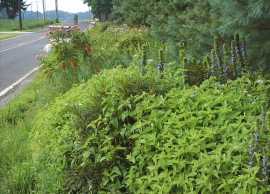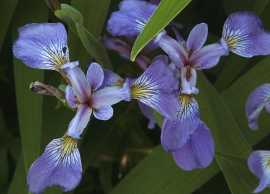- By Dan Segal
- Around Town
 Print
Print  Dan Segal on PlantsYou can have a lot of fun trying to define a rain garden. And with Ithaca's notorious meteorology, some might argue that every garden in the area is a rain garden. In fact, it's almost true. A rain garden is any garden that uses water-loving plants in areas of natural runoff, seepage, or even a high water table influenced by rainfall. It's a new twist on the old adage "right plant, right place". When you plant something that thrives on periodic inundation around your downspout, or in that part of the backyard that becomes a lake after a rain, you are rain gardening.
Dan Segal on PlantsYou can have a lot of fun trying to define a rain garden. And with Ithaca's notorious meteorology, some might argue that every garden in the area is a rain garden. In fact, it's almost true. A rain garden is any garden that uses water-loving plants in areas of natural runoff, seepage, or even a high water table influenced by rainfall. It's a new twist on the old adage "right plant, right place". When you plant something that thrives on periodic inundation around your downspout, or in that part of the backyard that becomes a lake after a rain, you are rain gardening.There are two basic reasons for the popularity of rain gardens: ecological and horticultural. Ecologically, rain gardens offer every home, building, parking lot or disturbed site a chance to capture, intercept, filter, and even recycle its own stormwater runoff, so that polluted water doesn't run directly into streams, rivers and lakes. Horticulturally, rain gardens offer an ornamental, low maintenance solution to problem wet areas.

In some parts of the country, rain gardens have been promoted for many years, through grants, state agencies, non-profit organizations, soil and water conservation districts, etc. In the more elaborate cases, rain gardens are designed and built from scratch and include excavation and grading to capture runoff and convey the water to a shallow basin. This basin may include some under drainage, so the water percolates rapidly or slowly, depending on the composition beneath the basin. In other cases, the basin may be configured so excess water slowly exits into a grass swale or another landscape feature that keeps the water from simply rushing out into a stream or storm drain loaded with sediment and pollutants. These basins allow the stormwater to pause long enough to reduce velocity. High velocity runoff is a problem because it results in physical damage in the form or erosion, and also holds pollutants in suspension.
Sounds intimidating and expensive? Don't worry. Rain gardening is easy and in your own yard, it can be as simple as knowing where your problem wet areas are and landscaping with plants that like that hydrology. A few simple tricks, like adding some flexible drain pipe to the bottom of your downspout, can make a huge difference and can turn a nagging puddle into a choice rain garden.
| On June 10 Rain Garden Training will be conducted at the Lansing Town Hall from 9am to noon. Sharon Anderson, of the Cayuga Lake Watershed Network, will be hosting the event. |
Whether on a large or small scale, the rain garden behaves somewhat like a floodplain. The floodplain is where nature deposits its extra water when the streams or rivers are full. It's a critical natural feature, the loss of which has much to do with flooding all over the world. Picture a raging river running at bankfull and high speed, suddenly topping its banks, and then the water slows down, spreads out over the floodplain, and drops its sediment because sediment suspended in fast-moving water drops out when the water slows down. This is why floodplains are graced with such rich soil. It's where the water slows down and drops silt.
So the rain garden is something like a flood plain, but in most cases, without the associated systems and complexity of a real river. Instead, our rain gardens represent the bankfull stage of our rooftops, gutters, driveways and sidewalks. Like a floodplain, the rain garden isn't always wet, so it's not the same as a permanent wetland. In dry summers, wetlands will remain pretty wet, but a rain garden can be as dry as any other part of your yard. Just like in the floodplain environment, plants must be adapted to this fluctuating water regime.

To get started, pick a place that's always wet and do a little research, or come out to the nursery. Choosing the right plants is easy with the right tools. Many wetland plants can handle long periods of relatively dry conditions, so these work well. But some don't, and these won't work in a rain garden. Similarly, some plants can handle periods of flooding despite their natural preference for dry soil, making them good candidates as well. Not only will you enjoy seeing that aggravating flood zone support appropriate life again, but it will be beautiful!
As with any other landscape project, defining the boundary is important, even if you blur that line later. In many cases it's easy to see from the outset, because the lawn has died out in the zone that stays wet too long after a rain. Defining your line doesn't mean you need edging or a hardscape border. But just as you would for a new perennial bed, it's important to mark out your rain garden. Don't just start plunking plants randomly into wet holes. They may be fine but you probably won't like the look.
Dan Segal ownsand operates the Plantsmen Nursery. Contact Dan with suggestions for future articles at This email address is being protected from spambots. You need JavaScript enabled to view it..
----
v2i20



